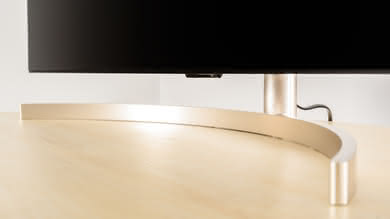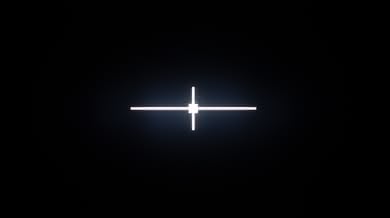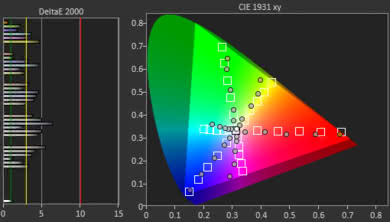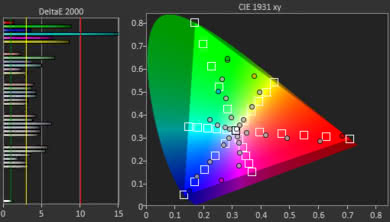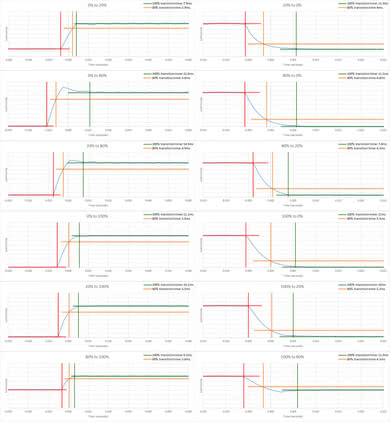Our Verdict
Very good mixed usage performance for the LG SK9500. The TV has excellent reflections, and excellent brightness, making a good choice for a variety of usages in bright environments. The gray uniformity is ordinary and that might annoy some sports fans but it has a great response time which is good for games and an ok viewing angle so that it can be placed in moderately wide rooms.
- Those with wide seating still get an accurate image
- Can get very bright
- Very good motion handling
- Dark scenes appear gray and blotchy
Decent performance of the LG 65SK9500PUA when watching movies. Contrast is ok and blacks cannot get very deep especially in a dark room and the local dimming cannot help improve the situation. This is somewhat expected on IPS panels. Although the black uniformity is not great, it does a great job upscaling content from Blu-ray.
Very good performance when watching TV shows. The TV gets quite bright to overcome glare and has excellent reflection handling, making it a good choice for bright rooms around the house. Viewing angles are ok. It is good at upscaling 720p and cable content so TV shows look great.
The LG 65SK9500 is very good for sports watching. It has the great response time to catch all the action. It handles reflections well and gets bright enough suitable for bright rooms. Also, the viewing angle is not bad so you can watch a game with a few friends, although you might notice some gray uniformity issues on panning shots.
Playing video games on this LG SK9500 is impressive. It has an amazing low input lag and excellent response time, providing an immersive gaming experience. It handles great a variety of input resolutions and although the contrast does not allow it to produce deep blacks, it will make most people happy.
This TV is okay for watching HDR movies. The contrast ratio is not so great and local dimming cannot help the TV display deep blacks in dark environments. Small highlights in HDR content are boosted and shown well. Colors are saturated and accurate, however, some clouding is visible in very dark scenes and that might bother some people.
This TV is impressive for playing HDR games. Colors are accurate and rich, input lag is low and response time is great so that the SK9500 can handle fast action well. There is a variety of inputs including the 4k @ 60Hz + HDR allowing you to have a nice HDR gaming experience.
Very good performance for this LG 65SK9500PUA as a PC monitor. It has excellent low input lag and feels very responsive to mouse movements. It does not have a permanent burn-in risk so one should not be afraid to use it as a monitor. Colors on the edges might look a little washed out when sitting too close to the screen due to average viewing angle performance.
Changelog
- Updated May 21, 2020: Converted to Test Bench 1.5.
- Updated Feb 21, 2020: Converted to Test Bench 1.4.
- Updated Feb 28, 2019: Converted to Test Bench 1.3.
- Updated Jun 26, 2018: Review published.
Check Price
Differences Between Sizes And Variants
We tested the 65" (65SK9500), the only size available at the moment.
If someone comes across a different type of panel or if their LG 65SK9500 doesn't correspond to our review, let us know and we will update the review.
| Size | Model |
| 65" | 65SK9500 |
Popular TV Comparisons

The LG SK9500 offers good performance for most viewing habits and is very well suited for bright rooms. See our recommendations for the best TVs and the best smart TVs.
The Samsung Q70R and the LG SK9500 have different panel types, each with its advantages and disadvantages. If you have a dark room, the Q70R is a better choice as it can deliver deeper and more uniform blacks that greatly improve dark room performance, thanks to its high contrast ratio. The Samsung Q70R also supports FreeSync, which is great for gamers. The LG SK9500, on the other hand, has wider viewing angles and can handle reflections better, so it's more suitable for a room with a wide seating arrangement and many light sources.
The Sony X900F is better than the LG SK9500. The Sony X900F is better for watching movies or HDR content right in front, as it has better native contrast ratio, better local dimming along, and better black uniformity. The Sony X900F also has a faster response time, which is great for watching sports. The LG SK9500 has an IPS panel that gives better viewing angles, and this is good for wide seating arrangements and a lower input lag that makes it very responsive for playing video games.
If you've got a bright room with wide seating, then the LG SK9500 is a better choice as it has better viewing angles and can handle reflections better and this is important when watching sports or TV shows. For a dark room, however, with seating directly in front, the Samsung NU8000 is better. The better contrast ratio and better black uniformity allow it to display deeper blacks in a dark room and thus you'll enjoy movies and HDR movies more on the Samsung NU8000. Finally, it supports FreeSync VRR, which is great for gamers.
The Samsung Q7CN/Q7C QLED 2018 is a bit better than the LG SK9500 unless you'll be watching from the side, in which case the LG is a better choice due to the wider viewing angles. When sitting directly in front, the Samsung Q7CN has deeper blacks in a dark room due to the higher native contrast ratio and better black uniformity. The Q7CN also has better gray uniformity and is better at handling bright room reflections. Finally, the Samsung Q7CN is a better choice for HDR gaming due to the lower input lag and support for the FreeSync variable refresh rate.

We buy and test dozens of TVs yearly, taking an objective, data-driven approach to deliver results you can trust. Our testing process is complex, with hundreds of individual tests that take over a week to complete. Most of our tests are done with specially designed test patterns that mimic real content, but we also use the same sources you have at home to ensure our results match the real-world experience. We use two main tools for our testing: a Colorimetry Research CR-100 colorimeter and a CR-250 spectroradiometer.
Test Results
The design of the LG 65SK9500PUA is excellent. It resembles last year's SJ9500. It comes with a metallic curved stand and premium feel. The back is plain and the inputs are accessible from the side if it is wall mounted. The build quality is great and there are no gaps or loose ends. Unfortunately, there is only very basic cable management and the stand prevents you from placing the soundbar directly in front of the TV.
The native contrast ratio on the LG 65SK9500 is decent, but blacks will look more grey than black when viewed in a dark room. This is less noticeable in a brightly lit room.
Contrast improves when local dimming, is enabled but again blacks will fade in dark environments.
The local dimming feature of the LG 65SK9500PUA is not very good. It reacts promptly to moving highlights, and dimming zones do turn on and off on time. The dimming algorithm is not too aggressive and thus clouding around highlights is obvious. It is quite similar to the performance of the SK9000 but slightly smoother.
We recommend setting it initially to High, but if the sudden brightness changes become unpleasant then Medium or Low can be a better choice.
The TV has excellent SDR peak brightness, bright enough for most rooms. Highlights are a little dim, most likely due to the poor local dimming.
This is brighter than the LG SK9000, which is beneficial for those in bright rooms with glare.
Very good HDR peak brightness. Very small highlights are displayed with good brightness and real scenes are quite bright. This is an improvement from last year's SJ9500 and from SK9000 where highlights were dimmed. However, the brightness is still far from the target 1000 cd/m² to fully appreciate HDR content.
The gray uniformity of the LG 65SK9500PUA is decent and very similar to the SK9000. In brighter scenes, the screen is a little darker on the sides compared to the center. Some dirty screen effect is present when viewing sports. This is not noticeable though on darker scenes.
The viewing angle is decent. It is better than most TVs with VA panels, but worse than TVs with OLED panels. Colors and brightness shift when one moves off of the center. This TV is an okay choice for a wide room where people will frequently be watching from the side.
The black uniformity is mediocre for this LG SK9500. There is clouding all over the screen and only the corners look black. However, things are considerably better when local dimming is enabled. The clouding is only apparent around the center of our test cross.
Great reflection handling on the LG 65SK9500PUA. The semi-gloss finish does diffuse reflections slightly and provides a very similar performance to the SK9000. This should be fine for most rooms, but reflections may be distracting in a very bright room or if sunlight falls directly on the TV.
It is bright enough to overcome most glare and it is our best outdoor TV. However, since it isn't meant for outdoor installation, it is important to properly protect it from the elements with a proper enclosure.
The out-of-the-box color accuracy is very good. The most accurate results were obtained with the Expert (Dark Room) picture mode. Color dE was good, but white balance dE was slightly higher and some people might notice some gray inaccuracy. The color temperature was warmer than our target and, giving everything a slightly red/yellow tint. This was a surprise since it was a change from the out-of-the-box color temperature we measured on the SK9000 which was cold.
Gamma was slightly lower than our target and this might cause some shadows to be darker.
The post-calibration colors of the LG SK9500 are excellent. White balance is almost perfect, color dE was good too. Gamma is very close to our target, shifting a little off target at the low end of our inputs, and color temperature is almost spot-on.
You can see our recommended settings here.
The TV is able to display a wide color gamut as it has a very good coverage of the P3 color space.
In the Cinema picture mode the HDR EOTF overshoots the target PQ curve at low stimulus levels, which will cause many shades in HDR scenes to be too bright. If users still find HDR content too dark, setting the TV's Dynamic Contrast setting to Medium raises the EOTF and brightens most HDR scenes. On the other hand, the EOTF in Game mode follows the target PQ curve very well.
The color volume is decent. However, the LG 65SK9500 is unable to produce deep, dark blacks due to its not so great contrast ratio. Color volume is worse than last year's SJ9500.
This LG 65SK9500PUA has very good gradient. Some medium banding is evident in many places, and some more major banding can be seen in red and blue.
In HDR, setting the MPEG Noise Reduction to Low reduces banding.
The LG SK9500 IPS TV does present some image retention. After the 10 minutes burn-in scene, as we can see on our test picture, the image retention is easily noticeable, but after 2 minutes of recovery, the retention is non-noticeable.
This is result is slightly disappointing and we were not expecting it judging from the results of the SK9000 or the LG SJ9500.
While IPS panels can have some temporary image retention, there doesn't appear to be any risk of permanent burn-in as seen in our long-term test.
The LG 65SK9500PUA uses PWM to dim the backlight. This helps clear the motion slightly but also results in duplications following fast-moving objects as seen in the motion blur box photo.
In order to dim the picture the backlight starts flickering at any Backlight setting other than 100. People sensitive to flicker should consider a nearly flicker-free alternative, like the Sony X900F or the LG C8.
The BFI function of this LGSK9500 is very good. To enable BFI in the Tru Motion menu set Motion Pro to on. This will flicker the backlight at 60Hz and will improve the blur. At the same time, the luminosity will increase so you will not notice any dimming. With 120 Hz content, the BFI options are grayed out as the TV is already flickering at its native frequency.
The LG 65SK9500 has excellent motion interpolation. Its native 120Hz panel can interpolate lower frame rate content up to 120 fps. It is nearly perfect during slow-moving shots, and it has a pretty conservative algorithm as it stops interpolating as soon as there is too much motion. Very few artifacts were seen during testing.
To activate Motion interpolation, in the TruMotion menu, enable De-judder to interpolate 30Hz content to 60Hz. Enable De-Blur to interpolate 60Hz content to 120Hz.
The stutter of this LG SK9500 is decent. The fast response time will create some stutter in slow fps content, but you can always use the motion interpolation to correct this. There is also some persistent motion blur that will reduce stutter.
The LG 65SK9500PUA is judder free when you set Real Cinema to on, no matter if the 24p signal is native or is coming through 60p or 60i. This is excellent for those who are sensitive to judder when watching 24p movies.
The LG 65SK9500PUA doesn't support any variable refresh rate features.
Outstanding low input lag that will keep any gamer happy. In PC mode all picture modes have the same low input lag, so we recommend Expert (Dark Room).
4:4:4 color is only shown properly in PC mode.
When Chroma 4:2:0 is used in HDR there is an extra 120 Hz frame (8.3 ms) of input lag. Please refer to the SK8000 input lag box review for a more detailed explanation.
The most common resolutions are supported on the LG 65SK9500 although 1440p is not supported.
4:4:4 Chroma is only properly displayed when the input icon is set to PC (aka PC mode).
When in PC Mode with HDR enabled, the TV does not properly support 4:4:4 color and colors appear washed out.
In PC Mode, Sharpness at 0 means no added sharpness.
Update 02/27/2019: While the TV doesn't support Atmos passthrough via a Dolby TrueHD carrier signal (common in Blu-ray disks), it is advertised as supporting Atmos passthrough via Dolby Digital Plus, which is the Atmos format used by some sources like Netflix; our testing confirmed this passthrough on the LG C8. We expect this to be true for the LG SK9500.
The frequency response of the LG 65SK9500 is decent. LFE (low-frequency extension) is at 76Hz, which is above-average. This means that this TV won't produce any thump or rumble, but will have a decent amount of body and punch to its bass. The response above the LFE point is quite well-balanced, which is important for producing clear dialogue. Also, this TV can get quite loud, but will produce some pumping and compression artifacts under maximum load. However, its room correction system (Magic Sound Tuning) wasn't able to remove the modes of our test room around 200Hz.
The distortion performance of the LG 65SK9500PUA is above average. At 80dB SPL, the THD performance is above-average. At maximum volume, although there is a rise in THD, it's still within decent limits, especially since this TV gets quite loud.
The webOS interface is very similar to the SK9000, with the improved search functionality. The menu is very fast and responsive.
We did not see any ads during testing. However, we have found ads on other 2018 LG TVs as shown here, so we assume all 2018 LG TVs have ads.
The LG 65SK9500PUA comes with most of the popular apps preloaded including Netflix, Amazon Video, Hulu and YouTube. There is the LG app store where you can get many more.
The remote is identical to the one found on all high-end LG TVs like the C8 and SK9000. It provides quick access to the most common functions of the TV. It can also be used as a pointer which is the fastest way to navigate the menus and even has a scroll wheel integrated in the d-pad.
The remote also works for voice commands and the TV understands basic commands such as changing inputs, opening YouTube, searching Netflix, etc... But it can not change the settings i.e 'Change backlight to 5' won't work.
It can also be used for setting a sleep timer and for more advanced searches, looking up weather or answering basic searches. Some searches are answered by LG's proprietary ThinQ AI; others were answered by Google Assistant, similar to Sony TVs like the X900F.


